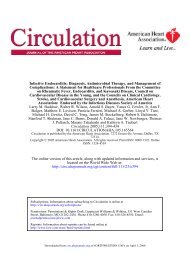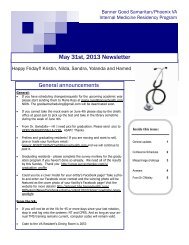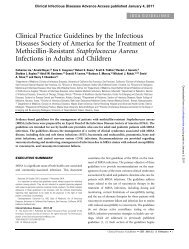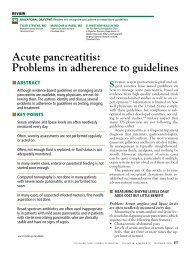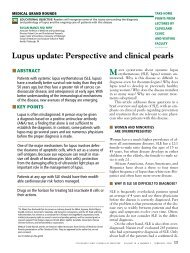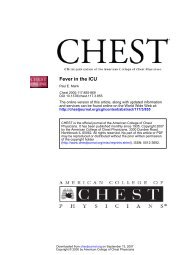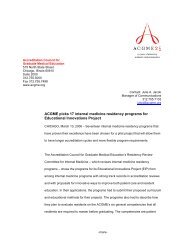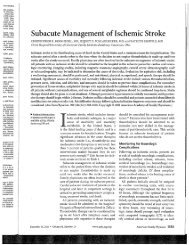011801 Acute Pharyngitis - Goodsamim.com
011801 Acute Pharyngitis - Goodsamim.com
011801 Acute Pharyngitis - Goodsamim.com
Create successful ePaper yourself
Turn your PDF publications into a flip-book with our unique Google optimized e-Paper software.
PRIMARY CARE<br />
Review Article<br />
Primary Care<br />
ACUTE PHARYNGITIS<br />
ALAN L. BISNO, M.D.<br />
ACUTE pharyngitis is one of the most <strong>com</strong>mon<br />
illnesses for which patients visit primary<br />
care physicians. According to the National<br />
Ambulatory Medical Care Survey, upper respiratory<br />
tract infections, including acute pharyngitis, are responsible<br />
for 200 visits to a physician per 1000 population<br />
annually in the United States 1 — a rate more<br />
than double that for any other category of infectious<br />
disease. The sore throat, fever, and malaise associated<br />
with acute pharyngitis are distressing, but with few<br />
exceptions, these illnesses are both benign and selflimited.<br />
Many bacterial and viral organisms are capable of<br />
inducing pharyngitis, either as a single manifestation<br />
or as part of a more generalized illness. A partial list<br />
of microorganisms that cause pharyngitis is presented<br />
in Table 1. 2 Strategies for diagnosis and treatment<br />
are directed at identifying those patients who require<br />
specific antimicrobial agents and attempting to minimize<br />
the unnecessary use of these agents. <strong>Pharyngitis</strong><br />
as part of the <strong>com</strong>mon cold will not be considered in<br />
detail in this review.<br />
STREPTOCOCCAL PHARYNGITIS<br />
Clinical Manifestations<br />
Group A streptococcus is by far the most <strong>com</strong>mon<br />
bacterial cause of acute pharyngitis, accounting for<br />
approximately 15 to 30 percent of cases in children<br />
and 5 to 10 percent of cases in adults. 3,4 Moreover,<br />
group A streptococcal pharyngitis is the only <strong>com</strong>mon<br />
form of the disease for which antimicrobial therapy is<br />
definitely indicated. Therefore, when a clinician evaluates<br />
a patient with acute sore throat, the most important<br />
clinical task is to decide whether or not the patient<br />
has “strep throat.” This illness occurs predominantly,<br />
though not exclusively, in school-age children. In tem-<br />
From the Department of Medicine, University of Miami School of Medicine<br />
and Miami Veterans Affairs Medical Center, Miami. Address reprint<br />
requests to Dr. Bisno at the Miami Veterans Affairs Medical Center, 1201<br />
NW 16th St., Miami, FL 33215.<br />
perate climates, the incidence is highest during the<br />
winter and early spring. The characteristic clinical findings<br />
are summarized in Table 2. Not all patients have<br />
the full-blown syndrome; many cases are milder and<br />
nonexudative, and patients who have undergone tonsillectomy<br />
may have milder symptoms. Children less<br />
than three years of age may have coryza and crusting<br />
of the nares; exudative pharyngitis is rare in this age<br />
group.<br />
Diagnosis<br />
The presence of such findings as tonsillopharyngeal<br />
exudate (Fig. 1) and anterior cervical lymphadenitis<br />
increases the statistical likelihood that the infectious<br />
agent is group A streptococcus. 6 A number of algorithms<br />
incorporating epidemiologic and clinical factors<br />
have been devised; these improve diagnostic accuracy<br />
primarily by identifying patients with an exceedingly<br />
low risk of streptococcal infection. 4,7,8 Indicators of low<br />
risk include the absence of fever (without the use of<br />
antipyretic agents), the absence of pharyngeal erythema,<br />
and the presence of obvious manifestations of the<br />
<strong>com</strong>mon cold.<br />
Unless streptococcal infection can be ruled out with<br />
confidence on the basis of clinical and epidemiologic<br />
evidence, however, patients with acute pharyngitis<br />
should be tested for the presence of group A streptococci<br />
in the throat, 5,9-11 by means of either a throat<br />
culture or a rapid test for group A streptococcal antigen.<br />
Physicians who rely on the clinical impression<br />
alone are likely to overtreat for fear of missing an infection<br />
that might result in acute rheumatic fever or<br />
in locally or systemically invasive disease. 3,12<br />
A properly performed and interpreted throat culture<br />
remains the gold standard for the diagnosis of group<br />
A streptococcal pharyngitis. It has a sensitivity of 90<br />
percent or higher, according to studies that used duplicate<br />
throat cultures. False negative results are likely<br />
in patients with small numbers of organisms in the<br />
pharynx, and many such patients are probably streptococcal<br />
carriers rather than acutely infected persons.<br />
The important factors involved in the throat culture<br />
(the proper method of swabbing; the optimal medium,<br />
time, and atmosphere for incubation; and an accurate<br />
reading of the plates) have been summarized in<br />
detail elsewhere. 9,13,14<br />
Obtaining definitive results from the throat culture<br />
takes between 24 and 48 hours. Delaying antimicrobial<br />
therapy for this period will not diminish its efficacy<br />
in preventing rheumatic fever, but it is often difficult<br />
to explain to patients or their parents the need<br />
to withhold therapy, particularly from a sick child. Indeed,<br />
in patients who appear acutely ill and in whom<br />
N Engl J Med, Vol. 344, No. 3 · January 18, 2001 · www.nejm.org · 205<br />
Downloaded from www.nejm.org at GALTER HEALTH SCIENCES LIBRARY on September 29, 2006 .<br />
Copyright © 2001 Massachusetts Medical Society. All rights reserved.
The New England Journal of Medicine<br />
TABLE 1. MICROBIAL CAUSES OF ACUTE PHARYNGITIS.*<br />
PATHOGEN<br />
SYNDROME OR DISEASE<br />
ESTIMATED<br />
PERCENTAGE<br />
OF CASES†<br />
Viral<br />
Rhinovirus (100 types and 1 subtype)<br />
Coronavirus (3 or more types)<br />
Adenovirus (types 3, 4, 7, 14, and 21)<br />
Herpes simplex virus (types 1 and 2)<br />
Parainfluenza virus (types 1–4)<br />
Influenzavirus (types A and B)<br />
Coxsackievirus A (types 2, 4–6, 8, and 10)<br />
Epstein–Barr virus<br />
Cytomegalovirus<br />
Human immunodeficiency virus type 1<br />
Bacterial<br />
Streptococcus pyogenes (group A b-hemolytic streptococci)<br />
Group C b-hemolytic streptococci<br />
Neisseria gonorrhoeae<br />
Corynebacterium diphtheriae<br />
Arcanobacterium haemolyticum<br />
Common cold<br />
Common cold<br />
Pharyngoconjunctival fever,<br />
acute respiratory disease<br />
Gingivitis, stomatitis, pharyngitis<br />
Common cold, croup<br />
Influenza<br />
Herpangina<br />
Infectious mononucleosis<br />
Infectious mononucleosis<br />
Primary human immunodeficiency<br />
virus infection<br />
<strong>Pharyngitis</strong> and tonsillitis, scarlet fever<br />
<strong>Pharyngitis</strong> and tonsillitis<br />
<strong>Pharyngitis</strong><br />
Diphtheria<br />
<strong>Pharyngitis</strong>, scarlatiniform rash<br />
*Adapted from Gwaltney and Bisno 2 with the permission of the publisher. The list is not exhaustive.<br />
†Estimates are of the percentage of cases of pharyngitis in persons of all ages that are due to the indicated organism.<br />
20<br />
»5<br />
5<br />
4<br />
2<br />
2<br />
PRIMARY CARE<br />
Figure 1. <strong>Acute</strong> Exudative Streptococcal <strong>Pharyngitis</strong> in an Adult.<br />
the throat culture, 15,16 but others have reported its sensitivity<br />
to be less than 80 percent. 17,18 These discrepancies<br />
need to be explained. The re<strong>com</strong>mendation<br />
to confirm negative results of rapid tests remains controversial,<br />
and some feel that the gain in sensitivity<br />
with the throat culture may not justify its cost and<br />
inconvenience and may not necessarily result in better<br />
out<strong>com</strong>es in areas where the incidence of acute rheumatic<br />
fever is quite low. 19 The development of more<br />
sensitive rapid diagnostic assays may render the issue<br />
moot. Meanwhile, physicians who elect to use optical<br />
immunoassay in children and adolescents without confirmation<br />
by culture should do so only after verifying<br />
that among the patients in their practice the assay has<br />
had a sensitivity similar to that of the standard throat<br />
culture. 10 Moreover, practitioners must be certain<br />
enough of the equivalent sensitivity to withhold antimicrobial<br />
therapy for children and adolescents when<br />
rapid tests are negative.<br />
Neither the conventional throat culture nor the<br />
rapid test reliably differentiates acutely infected patients<br />
from asymptomatic carriers with intercurrent viral<br />
pharyngitis. Indeed, the chief virtue of these tests<br />
in areas with a low incidence of rheumatic fever is that<br />
they allow physicians to withhold antibiotics from the<br />
majority of children and adolescents with sore throats,<br />
whose cultures will prove to be negative. This is very<br />
important in view of the fact that 70 percent of children<br />
and adolescents with sore throats who are seen<br />
in primary care settings in the United States receive<br />
prescriptions for antimicrobial agents. 20<br />
Given the low incidence of streptococcal pharyngitis<br />
and the minimal risk of acute rheumatic fever in<br />
persons over 20 years of age, it seems reasonable to rely<br />
on either a throat culture or a high-sensitivity rapid<br />
antigen-detection test without confirmation by culture<br />
in adults. The high specificity of the rapid tests (very<br />
few false positive results) should help prevent the needless<br />
use of antimicrobial agents in adults with acute<br />
pharyngitis.<br />
Therapy<br />
The objectives of therapy for group A streptococcal<br />
pharyngitis are to prevent suppurative <strong>com</strong>plications<br />
(peritonsillar or retropharyngeal abscess, cervical lymphadenitis,<br />
mastoiditis, sinusitis, and otitis media), prevent<br />
rheumatic fever, decrease infectivity so that the<br />
patient can return to school or work, and shorten the<br />
clinical course of the disease. 21,22 The last objective can<br />
usually be ac<strong>com</strong>plished only if the patient is treated<br />
early in the course of the illness, because in the great<br />
majority of patients with streptococcal sore throats,<br />
the symptoms improve within three to four days even<br />
without therapy. 23 There is no firm evidence that treatment<br />
of the antecedent streptococcal throat infection<br />
can prevent the development of acute glomerulonephritis.<br />
Penicillin, to which the organism is uniformly susceptible,<br />
remains the treatment of choice for group<br />
A streptococcal pharyngitis because of its proven efficacy,<br />
narrow spectrum, safety, and low cost. If oral<br />
therapy is elected, a full 10-day course of treatment is<br />
necessary to ensure the maximal rate of eradication<br />
of the infection from the pharynx 24 (Table 3). Recent<br />
N Engl J Med, Vol. 344, No. 3 · January 18, 2001 · www.nejm.org · 207<br />
Downloaded from www.nejm.org at GALTER HEALTH SCIENCES LIBRARY on September 29, 2006 .<br />
Copyright © 2001 Massachusetts Medical Society. All rights reserved.
The New England Journal of Medicine<br />
studies suggest that treatment for 10 days with a single<br />
daily dose of amoxicillin is as effective as treatment<br />
with multiple daily doses of penicillin V. 25 If this finding<br />
is confirmed, the amoxicillin regimen may be considered<br />
as a simple and economical alternative to penicillin.<br />
The slightly higher rate of eradication achievable<br />
with cephalosporins 26 may be due to the superior efficacy<br />
of these drugs in eradicating carriage 27 and does<br />
not justify the routine use of these more expensive and<br />
broader-spectrum antibiotics. Although erythromycin<br />
should be the drug of first choice in patients with an<br />
allergy to penicillin that is not of the immediate type,<br />
oral cephalosporins are a reasonable second choice in<br />
such cases.<br />
Treatment with a number of antimicrobial agents,<br />
including azithromycin, cefuroxime, cefdinir, cefixime,<br />
and cefpodoxime, has been reported to result in rates<br />
of streptococcal eradication at 5 days that are similar<br />
to the rates achieved with penicillin at 10 days, but<br />
cost and effects on patterns of antimicrobial resistance<br />
must still be considered. Azithromycin has several appealing<br />
features: it can be given in a single daily dose,<br />
it is better tolerated than erythromycin in patients<br />
who are allergic to penicillin, and it may be effective<br />
in five-day courses. However, the current average<br />
wholesale price of a 5-day course of azithromycin<br />
tablets at the re<strong>com</strong>mended dosage is $40, as <strong>com</strong>pared<br />
with $1.75 for a 10-day course of penicillin V<br />
(250 mg three times a day). Moreover, streptococcal<br />
resistance to macrolides develops rapidly with extensive<br />
use of these drugs, which is not the case with<br />
penicillin 28 ; therefore, the use of newer macrolides,<br />
such as azithromycin, as first-line therapy should be<br />
avoided.<br />
With rare exceptions, 9 neither post-treatment throat<br />
cultures of asymptomatic patients nor routine cultures<br />
of asymptomatic family contacts are necessary. The<br />
treatment of recurrent and relapsing pharyngitis, including<br />
suggested antimicrobial regimens, has recently<br />
been reviewed. 9,14<br />
<strong>Pharyngitis</strong> Due to Non–Group A Streptococci<br />
Streptococci of serogroups C and G have been responsible<br />
for foodborne and waterborne outbreaks of<br />
pharyngitis and for cases that led to acute glomerulonephritis.<br />
These organisms may also cause sporadic<br />
cases of pharyngitis that mimic group A streptococcal<br />
pharyngitis but are generally less severe. 29 Because<br />
group C and group G streptococci are often <strong>com</strong>mensals<br />
of the upper respiratory tract, it is quite difficult<br />
to differentiate colonization from infection. The benefit,<br />
if any, of antimicrobial therapy is unknown. The<br />
antimicrobial agents used to treat group A streptococci<br />
(Table 3) would be appropriate for non–group<br />
A organisms; the duration of treatment should be<br />
shorter, however, since non–group A streptococci have<br />
never been shown to cause acute rheumatic fever.<br />
DIPHTHERIA<br />
Pharyngeal diphtheria is now extremely rare in the<br />
United States. A single probable case was reported<br />
to the Centers for Disease Control and Prevention<br />
in 1998. The disease occurs primarily among unimmunized<br />
or poorly immunized members of socioeconomically<br />
disadvantaged groups. 30 The most notable<br />
physical finding is the grayish brown diphtheritic<br />
pseudomembrane, which may involve one or both<br />
tonsils or may extend widely to involve the nares, uvula,<br />
soft palate, pharynx, larynx, and tracheobronchial<br />
tree. Involvement of the latter structures can cause<br />
TABLE 3. ANTIMICROBIAL THERAPY FOR GROUP A STREPTOCOCCAL PHARYNGITIS.*<br />
DRUG DOSE DURATION<br />
Oral<br />
PenicillinV†<br />
Intramuscular<br />
Penicillin G benzathine<br />
Penicillin G benzathine <strong>com</strong>bined<br />
with penicillin G procaine‡<br />
For patients allergic to penicillin§<br />
Erythromycin estolate<br />
Erythromycin ethylsuccinate<br />
Erythromycin stearate<br />
250 mg 2 or 3 times daily for children<br />
250 mg 4 times daily or 500 mg 2 times daily for adolescents and adults<br />
600,000 units for patients weighing «27 kg (60 lb)<br />
1,200,000 units for patients weighing >27 kg<br />
1,200,000 units<br />
20–40 mg per kilogram of body weight orally per day, divided into 2 to 4 doses<br />
(maximum, 1 g/day)<br />
40 mg per kilogram per day, divided into 2 to 4 oral doses (maximum, 1 g/day)<br />
1 g per day, divided into 2 or 4 oral doses for adolescents and adults<br />
10 days<br />
1 dose<br />
1 dose<br />
10 days<br />
10 days<br />
*Data are from Dajani et al. 5 and Bisno et al. 9 and other sources.<br />
†For the purpose of palatability, amoxicillin suspension may be used in children who are unable to swallow tablets.<br />
‡This <strong>com</strong>bination contains only 900,000 units of penicillin G benzathine and is not re<strong>com</strong>mended for adolescents or adults.<br />
§First- and second-generation cephalosporins are acceptable alternatives to erythromycin in patients who do not have immediate hypersensitivity<br />
to penicillin. Azithromycin is also an acceptable alternative to erythromycin.<br />
208 · N Engl J Med, Vol. 344, No. 3 · January 18, 2001 · www.nejm.org<br />
Downloaded from www.nejm.org at GALTER HEALTH SCIENCES LIBRARY on September 29, 2006 .<br />
Copyright © 2001 Massachusetts Medical Society. All rights reserved.
PRIMARY CARE<br />
life-threatening respiratory obstruction. Removal of<br />
the membrane reveals a bleeding and edematous submucosa.<br />
Soft-tissue edema and prominent cervical and<br />
submental adenopathy may create a bull-neck appearance.<br />
The potent toxin elaborated by Corynebacterium<br />
diphtheriae may produce cardiac toxicity and neurotoxicity.<br />
The diagnosis, which may be strongly suspected<br />
on epidemiologic and clinical grounds, should<br />
be confirmed by culture of the pseudomembrane in<br />
Loeffler’s or tellurite selective medium. Pharyngeal<br />
diphtheria is treated with equine hyperimmune diphtheria<br />
antitoxin and penicillin or erythromycin.<br />
OTHER BACTERIAL INFECTIONS<br />
Arcanobacterium haemolyticum is a rarely diagnosed<br />
cause of acute pharyngitis and tonsillitis that tends<br />
to occur in adolescents and young adults. The symptoms<br />
of infection with this organism closely mimic<br />
those of acute streptococcal pharyngitis, including a<br />
scarlatiniform rash in many patients. 31,32 A. haemolyticum<br />
infection should be suspected in patients with<br />
these findings in whom the throat culture is negative<br />
for group A streptococci. The organism may be detected<br />
more readily on human-blood agar plates than<br />
on those containing sheep’s blood and thus may be<br />
missed on routine cultures. In rare cases, A. haemolyticum<br />
produces a membranous pharyngitis that can be<br />
confused with diphtheria. Erythromycin is the preferred<br />
drug for treatment.<br />
Although colonization of the pharynx with Neisseria<br />
gonorrhoeae is usually asymptomatic, clinically<br />
apparent pharyngitis sometimes develops, and pharyngeal<br />
colonization may be associated with disseminated<br />
disease. 33 Gonococcal pharyngitis should be<br />
suspected, particularly in women and homosexual men<br />
who practice fellatio. The diagnosis should be confirmed<br />
by culture on Thayer–Martin medium. If the<br />
case is un<strong>com</strong>plicated, treatment consists of either a<br />
single dose of intramuscular ceftriaxone (125 mg) or<br />
a single dose of an oral quinolone (ciprofloxacin,<br />
500 mg, or ofloxacin, 400 mg), plus either a single<br />
dose of azithromycin (1 g) or doxycycline (100 mg)<br />
twice daily for seven days for possible chlamydial coinfection<br />
at genital sites. 34 Doxycycline and ofloxacin<br />
should not be prescribed for pregnant women.<br />
VIRAL INFECTIONS<br />
Infectious Mononucleosis<br />
Infectious mononucleosis is caused by Epstein–Barr<br />
virus, a member of the Herpesviridae family. Most<br />
clinically apparent cases occur in persons between 15<br />
and 24 years of age. After a prodromal period of chills,<br />
sweats, feverishness, and malaise, the disease presents<br />
with the classic triad of severe sore throat, fever (a temperature<br />
as high as 38°C to 40°C), and lymphadenopathy.<br />
The tonsils are enlarged, the pharynx is<br />
erythematous and often covered with a thick continuous<br />
exudate, and palatal petechiae may be evident.<br />
Posterior and anterior cervical lymphadenopathy is<br />
most prominent, but axillary and inguinal nodes are<br />
also frequently enlarged. Splenomegaly is present in<br />
50 percent of cases, hepatomegaly in approximately<br />
10 to 15 percent, and jaundice in 5 percent. 35 About<br />
5 percent of patients have a rash of variable morphology,<br />
and the administration of ampicillin will provoke<br />
a pruritic maculopapular eruption in nearly all patients.<br />
The hematologic findings include relative and absolute<br />
lymphocytosis, with more than 10 percent atypical<br />
lymphocytes, and thrombocytopenia that is usually<br />
mild but may occasionally be severe. Heterophil<br />
antibodies that agglutinate sheep erythrocytes after<br />
absorption with guinea-pig kidney are present in approximately<br />
90 percent of affected adolescents and<br />
adults within the first two to three weeks of illness.<br />
Horse red-cell agglutinins are more sensitive, although<br />
the results must be interpreted cautiously since heterophil<br />
antibodies may persist in serum for a year or<br />
more after the acute phase of the illness. 36 Spot and<br />
slide tests that use horse or purified bovine erythrocytes<br />
and allow rapid screening for heterophil antibodies<br />
are now <strong>com</strong>mercially available. 37 These tests<br />
are highly specific, and a positive result in conjunction<br />
with clinically <strong>com</strong>patible illness may be considered<br />
diagnostic. False negative results of heterophil tests<br />
are <strong>com</strong>mon in children, particularly those less than<br />
four years of age. For heterophil-negative or atypical<br />
cases, specific antibodies to a number of viral antigens<br />
can be measured. The most useful of these for general<br />
clinical purposes is the IgM antibody to viral capsid<br />
antigen.<br />
The most <strong>com</strong>mon entities that should be considered<br />
in the differential diagnosis of infectious mononucleosis<br />
are streptococcal pharyngitis (which it may<br />
closely mimic in the early stages), cytomegalovirus infection,<br />
and the acute retroviral syndrome. Less frequently,<br />
infection with hepatitis A virus, Toxoplasma<br />
gondii, human herpesvirus 6, or rubella virus may<br />
mimic some aspects of infectious mononucleosis. Although<br />
a number of antiviral drugs have activity<br />
against Epstein–Barr virus in vivo, none have proved<br />
useful in primary care practice. 38 Treatment should<br />
be focused on the control of symptoms, and patients<br />
should be cautioned against vigorous activities that<br />
might produce splenic rupture during at least the first<br />
month after the onset of illness. 39 Corticosteroids produce<br />
symptomatic improvement, but their use in this<br />
usually benign and self-limited illness is not generally<br />
re<strong>com</strong>mended. They are indicated if the patient has<br />
tonsillar hypertrophy that threatens to obstruct the airway,<br />
severe thrombocytopenia, or hemolytic anemia.<br />
<strong>Acute</strong> Retroviral Syndrome<br />
The acute retroviral syndrome is an increasingly<br />
recognized manifestation of primary infection with the<br />
human immunodeficiency virus (HIV). After an incubation<br />
period that may be as short as six days but is<br />
N Engl J Med, Vol. 344, No. 3 · January 18, 2001 · www.nejm.org · 209<br />
Downloaded from www.nejm.org at GALTER HEALTH SCIENCES LIBRARY on September 29, 2006 .<br />
Copyright © 2001 Massachusetts Medical Society. All rights reserved.
The New England Journal of Medicine<br />
usually three to five weeks, symptoms develop that<br />
include fever, nonexudative pharyngitis, lymphadenopathy,<br />
and systemic symptoms such as arthralgia, myalgia,<br />
and lethargy. Maculopapular rash is present in<br />
40 to 80 percent of patients. The illness sometimes<br />
resembles infectious mononucleosis, but it can be differentiated<br />
from mononucleosis by its more acute onset,<br />
the absence of exudate and of prominent tonsillar<br />
hypertrophy, and often the occurrence of a rash (which<br />
is rare in mononucleosis except after treatment with<br />
ampicillin) and mucocutaneous ulceration. 40 Tests for<br />
HIV antibodies are often negative during the acute<br />
phase of illness, but assays for HIV type 1 RNA or<br />
p24 antigen will confirm the diagnosis. Most authorities<br />
favor the initiation of maximally suppressive <strong>com</strong>binations<br />
of antiretroviral drugs during this acute<br />
phase of HIV infection. 41<br />
Other Viruses<br />
In addition to nonspecific sore throats, some respiratory<br />
viruses produce more distinctive clinical syndromes.<br />
Adenoviruses can produce pharyngoconjunctival<br />
fever or an influenza-like syndrome known as the<br />
acute respiratory disease of military recruits. 42 Coxsackieviruses<br />
are the most frequent causes of handfoot-and-mouth<br />
disease and herpangina (Fig. 2). 43<br />
Several studies have documented primary human<br />
herpesvirus 1 infection as a cause of pharyngitis, often<br />
exudative, in college students. 44,45 Human herpesvirus<br />
2 can occasionally cause a similar illness as a consequence<br />
of oral–genital sexual contact. 46 Although<br />
primary herpesvirus infections may involve the anterior<br />
portion of the oral cavity (gingivostomatitis), they<br />
do not routinely do so.<br />
OTHER INFECTIOUS AGENTS<br />
Mycoplasma pneumoniae is isolated with varying frequency<br />
from patients with symptomatic pharyngitis<br />
but also from controls. Although it probably causes<br />
some cases of acute pharyngitis, the frequency of such<br />
cases remains uncertain. 47-49 Chlamydia pneumoniae<br />
has been reported to cause fever, cough, and sore<br />
throat, either as an isolated syndrome, or together with<br />
or preceding pneumonia. 50 When unassociated with<br />
lower respiratory tract disease, neither of these microbial<br />
agents is likely to be diagnosed during the acute<br />
phase of illness with the routine tests available to primary<br />
care physicians. Both organisms respond to therapy<br />
with tetracycline or erythromycin.<br />
TREATMENT<br />
During the acute phase of pharyngitis, patients<br />
with severe symptoms will benefit from rest, maintenance<br />
of an adequate fluid intake, antipyretic drugs,<br />
and gargling with warm salt water. Over-the-counter<br />
lozenges containing menthol and mild local anesthetics<br />
also provide temporary relief from severe throat<br />
pain. For bacterial pharyngitis, antimicrobial therapy<br />
should be administered according to the guidelines<br />
given above. For the great majority of cases of pharyngitis,<br />
which have nonbacterial causes, no further therapy<br />
is necessary. Although it can be difficult, primary<br />
care physicians have the responsibility to educate their<br />
patients about the self-limited nature of viral pharyngitis<br />
and the hazards of indiscriminate use of antimicrobial<br />
agents for both the patient and the <strong>com</strong>munity.<br />
SUMMARY<br />
The primary care physician needs to identify those<br />
patients with acute pharyngitis who require specific<br />
antimicrobial therapy and to avoid unnecessary and<br />
potentially deleterious treatment in the large majority<br />
of patients who have a benign, self-limited infection<br />
that is usually viral. In most cases, differentiating between<br />
these two types of infection can be ac<strong>com</strong>plished<br />
easily if the physician considers the epidemiologic<br />
setting, the history, and the physical findings,<br />
plus the results of a few readily available laboratory<br />
tests. When antimicrobial therapy is required, the safest,<br />
narrowest-spectrum, and most cost-effective drugs<br />
should be used. Despite agreement on these principles<br />
by expert advisory <strong>com</strong>mittees, 5,9,10 data from<br />
national surveys of ambulatory care indicate that antimicrobial<br />
agents continue to be prescribed indiscriminately<br />
for upper respiratory infections.<br />
I am indebted to Daniel Musher, M.D., for his advice.<br />
Figure 2. Palatal Lesions of Herpangina in a Teenager with Severe<br />
Throat Pain.<br />
Multiple white papules and vesicles are present on an erythematous<br />
base. Reprinted from Read 43 with the permission of the<br />
publisher.<br />
REFERENCES<br />
1. Armstrong GL, Pinner RW. Outpatient visits for infectious diseases<br />
in the United States, 1980 through 1996. Arch Intern Med 1999;159:<br />
2531-6.<br />
2. Gwaltney JM Jr, Bisno AL. <strong>Pharyngitis</strong>. In: Mandell GL, Bennett JE,<br />
210 · N Engl J Med, Vol. 344, No. 3 · January 18, 2001 · www.nejm.org<br />
Downloaded from www.nejm.org at GALTER HEALTH SCIENCES LIBRARY on September 29, 2006 .<br />
Copyright © 2001 Massachusetts Medical Society. All rights reserved.
PRIMARY CARE<br />
Dolin R, eds. Mandell, Douglas, and Bennett’s principles and practice of<br />
infectious diseases. 5th ed. Vol. 1. Philadelphia: Churchill Livingstone,<br />
2000:656-62.<br />
3. Poses RM, Cebul RD, Collins M, Fager SS. The accuracy of experienced<br />
physicians’ probability estimates for patients with sore throats: implications<br />
for decision making. JAMA 1985;254:925-9.<br />
4. Komaroff AL, Pass TM, Aronson MD, et al. The prediction of streptococcal<br />
pharyngitis in adults. J Gen Intern Med 1986;1:1-7.<br />
5. Dajani A, Taubert K, Ferrieri P, Peter G, Shulman S. Treatment of acute<br />
streptococcal pharyngitis and prevention of rheumatic fever: a statement<br />
for health professionals. Pediatrics 1995;96:758-64.<br />
6. Kaplan EL, Top FH Jr, Dudding BA, Wannamaker LW. Diagnosis of<br />
streptococcal pharyngitis: differentiation of active infection from the carrier<br />
state in the symptomatic child. J Infect Dis 1971;123:490-501.<br />
7. Breese BB. A simple scorecard for the tentative diagnosis of streptococcal<br />
pharyngitis. Am J Dis Child 1977;131:514-7.<br />
8. Wald ER, Green MD, Schwartz B, Barbadora K. A streptococcal score<br />
card revisited. Pediatr Emerg Care 1998;14:109-11.<br />
9. Bisno AL, Gerber MA, Gwaltney JM Jr, Kaplan EL, Schwartz RH. Diagnosis<br />
and management of group A streptococcal pharyngitis: a practice<br />
guideline. Clin Infect Dis 1997;25:574-83.<br />
10. Group A streptococcal infections. In: Pickering LK, ed. 2000 Red<br />
book: report of the Committee on Infectious Diseases. 25th ed. Elk Grove<br />
Village, Ill.: American Academy of Pediatrics, 2000:526-36.<br />
11. Schwartz RH, Gerber MA, McKay K. Pharyngeal findings of group A<br />
streptococcal pharyngitis. Arch Pediatr Adolesc Med 1998;152:927-8.<br />
12. Duff BA, Denny FW, Kiska DL, Lohr JA. Invasive group A streptococcal<br />
disease in children. Clin Pediatr (Phila) 1999;38:417-23.<br />
13. Kellogg JA. Suitability of throat culture procedures for detection of<br />
group A streptococci and as reference standards for evaluation of streptococcal<br />
antigen detection kits. J Clin Microbiol 1990;28:165-9.<br />
14. Shulman ST, Tanz RR, Gerber MA. Streptococcal pharyngitis. In:<br />
Stevens DL, Kaplan EL, eds. Streptococcal infections: clinical aspects, microbiology,<br />
and molecular pathogenesis. New York: Oxford University<br />
Press, 2000:76-101.<br />
15. Gerber MA, Tanz RR, Kabat W, et al. Optical immunoassay test for<br />
group A b-hemolytic streptococcal pharyngitis: an office-based, multicenter<br />
investigation. JAMA 1997;277:899-903.<br />
16. Fries SM. Diagnosis of group A streptococcal pharyngitis in a private<br />
clinic: <strong>com</strong>parative evaluation of an optical immunoassay method and culture.<br />
J Pediatr 1995;126:933-6.<br />
17. Schlager TA, Hayden GA, Woods WA, Dudley SM, Hendley JO. Optical<br />
immunoassay for rapid detection of group A beta-hemolytic streptococci:<br />
should culture be replaced? Arch Pediatr Adolesc Med 1996;150:245-8.<br />
18. Pitetti RD, Drenning SD, Wald ER. Evaluation of a new rapid antigen<br />
detection kit for group A beta-hemolytic streptococci. Pediatr Emerg Care<br />
1998;14:396-8.<br />
19. Webb KH. Does culture confirmation of high-sensitivity rapid streptococcal<br />
tests make sense? A medical decision analysis. Pediatrics 1998;101:<br />
299. abstract.<br />
20. Nyquist AC, Gonzales R, Steiner JF, Sande MA. Antibiotic prescribing<br />
for children with colds, upper respiratory tract infections, and bronchitis.<br />
JAMA 1998;279:875-7. [Erratum, JAMA 1998;279:1702.]<br />
21. Krober MS, Bass JW, Michels GN. Streptococcal pharyngitis: placebocontrolled<br />
double-blind evaluation of clinical response to penicillin therapy.<br />
JAMA 1985;253:1271-4.<br />
22. Randolph MF, Gerber MA, DeMeo KK, Wright L. Effect of antibiotic<br />
therapy on the clinical course of streptococcal pharyngitis. J Pediatr 1985;<br />
106:870-5.<br />
23. Brink WR, Rammelkamp CH Jr, Denny FW, Wannamaker LW. Effect<br />
of penicillin and aureomycin on the natural course of streptococcal tonsillitis<br />
and pharyngitis. Am J Med 1951;10:300-8.<br />
24. Schwartz RH, Wientzen RL Jr, Pedreira F, Feroli EJ, Mella GW, Guandolo<br />
VL. Penicillin V for group A streptococcal pharyngotonsillitis: a randomized<br />
trial of seven vs ten days’ therapy. JAMA 1981;246:1790-5.<br />
25. Feder HMJ, Gerber MA, Randolph MF, Stelmach PS, Kaplan EL.<br />
Once-daily therapy for streptococcal pharyngitis with amoxicillin. Pediatrics<br />
1999;103:47-51.<br />
26. Pichichero ME, Margolis PA. A <strong>com</strong>parison of cephalosporins and<br />
penicillins in the treatment of group A beta-hemolytic streptococcal pharyngitis:<br />
a meta-analysis supporting the concept of microbial copathogenicity.<br />
Pediatr Infect Dis J 1991;10:275-81.<br />
27. Gerber MA, Tanz RR, Kabat W, et al. Potential mechanisms for failure<br />
to eradicate group A streptococci from the pharynx. Pediatrics 1999;104:<br />
911-7.<br />
28. Seppälä H, Klaukka T, Vuopio-Varkila J, et al. The effect of changes<br />
in the consumption of macrolide antibiotics on erythromycin resistance in<br />
group A streptococci in Finland. N Engl J Med 1997;337:441-6.<br />
29. Oster HR, Bisno AL. Group C and group G streptococcal infections:<br />
epidemiology and clinical aspects. In: Fischetti VA, Novick RP, Ferreti JJ,<br />
Portnoy DA, Rood JI, eds. Gram-positive pathogens. Washington, D.C.:<br />
ASM Press, 2000:184-90.<br />
30. Bisgard KM, Hardy IR, Popovic T, et al. Respiratory diphtheria in the<br />
United States, 1980 through 1995. Am J Public Health 1998;88:787-91.<br />
31. Karpathios T, Drakonaki S, Zervoudaki A, et al. Arcanobacterium<br />
haemolyticum in children with presumed streptococcal pharyngotonsillitis<br />
or scarlet fever. J Pediatr 1992;121:735-7.<br />
32. Miller RA, Brancato F, Holmes KK. Corynebacterium hemolyticum as<br />
a cause of pharyngitis and scarlatiniform rash in young adults. Ann Intern<br />
Med 1986;105:867-72.<br />
33. Wiesner PJ, Tronca E, Bonin P, Pederson AHB, Holmes KK. Clinical<br />
spectrum of pharyngeal gonococcal infection. N Engl J Med 1973;288:<br />
181-5.<br />
34. 1998 Guidelines for treatment of sexually transmitted diseases.<br />
MMWR Morb Mortal Wkly Rep 1998;47(RR-1):59-69.<br />
35. Schooley RT. Epstein-Barr virus (infectious mononucleosis). In: Mandell<br />
GL, Bennett JE, Dolin R, eds. Mandell, Douglas, and Bennett’s principles<br />
and practice of infectious diseases. 5th ed. Vol. 2. Philadelphia:<br />
Churchill Livingstone, 2000:1599-613.<br />
36. Evans AS, Niederman JC, Cenabre LC, West B, Richards VA. A prospective<br />
evaluation of heterophile and Epstein-Barr virus-specific IgM antibody<br />
tests in clinical and subclinical infectious mononucleosis: specificity<br />
and sensitivity of the tests and persistence of antibody. J Infect Dis 1975;<br />
132:546-54.<br />
37. Linderholm M, Boman J, Juto P, Linde A. Comparative evaluation of<br />
nine kits for rapid diagnosis of infectious mononucleosis and Epstein-Barr<br />
virus-specific serology. J Clin Microbiol 1994;32:259-61.<br />
38. Andersson J, Skoldenberg B, Henle W, et al. Acyclovir treatment in<br />
infectious mononucleosis: a clinical and virological study. Infection 1987;<br />
15:Suppl 1:S14-S20.<br />
39. Hoagland RJ, Henson HM. Splenic rupture in infectious mononucleosis.<br />
Ann Intern Med 1957;46:1184-91.<br />
40. Vanhems P, Allard R, Cooper DA, et al. <strong>Acute</strong> human immunodeficiency<br />
virus type 1 disease as a mononucleosis-like illness: is the diagnosis<br />
too restrictive? Clin Infect Dis 1997;24:965-70. [Erratum, Clin Infect Dis<br />
1997;25:352.]<br />
41. Kahn JO, Walker BD. <strong>Acute</strong> human immunodeficiency virus type 1 infection.<br />
N Engl J Med 1998;339:33-9.<br />
42. Hendrix RM, Lindner JL, Benton FR, et al. Large, persistent epidemic<br />
of adenovirus type 4-associated acute respiratory disease in U.S. Army<br />
trainees. Emerg Infect Dis 1999;5:798-801.<br />
43. Read RC. Orocervical and esophageal infection. In: Armstrong D, Cohen<br />
J, eds. Infectious diseases. Section 2. London: Harcourt, 1999:33-1–<br />
33-10.<br />
44. McMillan JA, Weiner LB, Higgins AM, Lamparella VJ. <strong>Pharyngitis</strong> associated<br />
with herpes simplex virus in college students. Pediatr Infect Dis J<br />
1993;12:280-4.<br />
45. Glezen WP, Fernald GW, Lohr JA. <strong>Acute</strong> respiratory disease of university<br />
students with special reference to the etiologic role of Herpesvirus hominis.<br />
Am J Epidemiol 1975;101:111-21.<br />
46. Young EJ, Vainrub B, Musher DM, et al. <strong>Acute</strong> pharyngotonsillitis<br />
caused by herpesvirus type 2. JAMA 1978;239:1885-6.<br />
47. McMillan JA, Sandstrom C, Weiner LB, et al. Viral and bacterial organisms<br />
associated with acute pharyngitis in a school-aged population.<br />
J Pediatr 1986;109:747-52.<br />
48. Glezen WP, Clyde WA Jr, Senior RJ, Sheaffer CI, Denny FW. Group<br />
A streptococci, mycoplasmas, and viruses associated with acute pharyngitis.<br />
JAMA 1967;202:455-60.<br />
49. Williams WC, Williamson HA Jr, LeFevre ML. The prevalence of Mycoplasma<br />
pneumoniae in ambulatory patients with nonstreptococcal sore<br />
throat. Fam Med 1991;23:117-21.<br />
50. Grayston JT. Infections caused by Chlamydia pneumoniae strain<br />
TWAR. Clin Infect Dis 1992;15:757-61.<br />
Copyright © 2001 Massachusetts Medical Society.<br />
N Engl J Med, Vol. 344, No. 3 · January 18, 2001 · www.nejm.org · 211<br />
Downloaded from www.nejm.org at GALTER HEALTH SCIENCES LIBRARY on September 29, 2006 .<br />
Copyright © 2001 Massachusetts Medical Society. All rights reserved.



